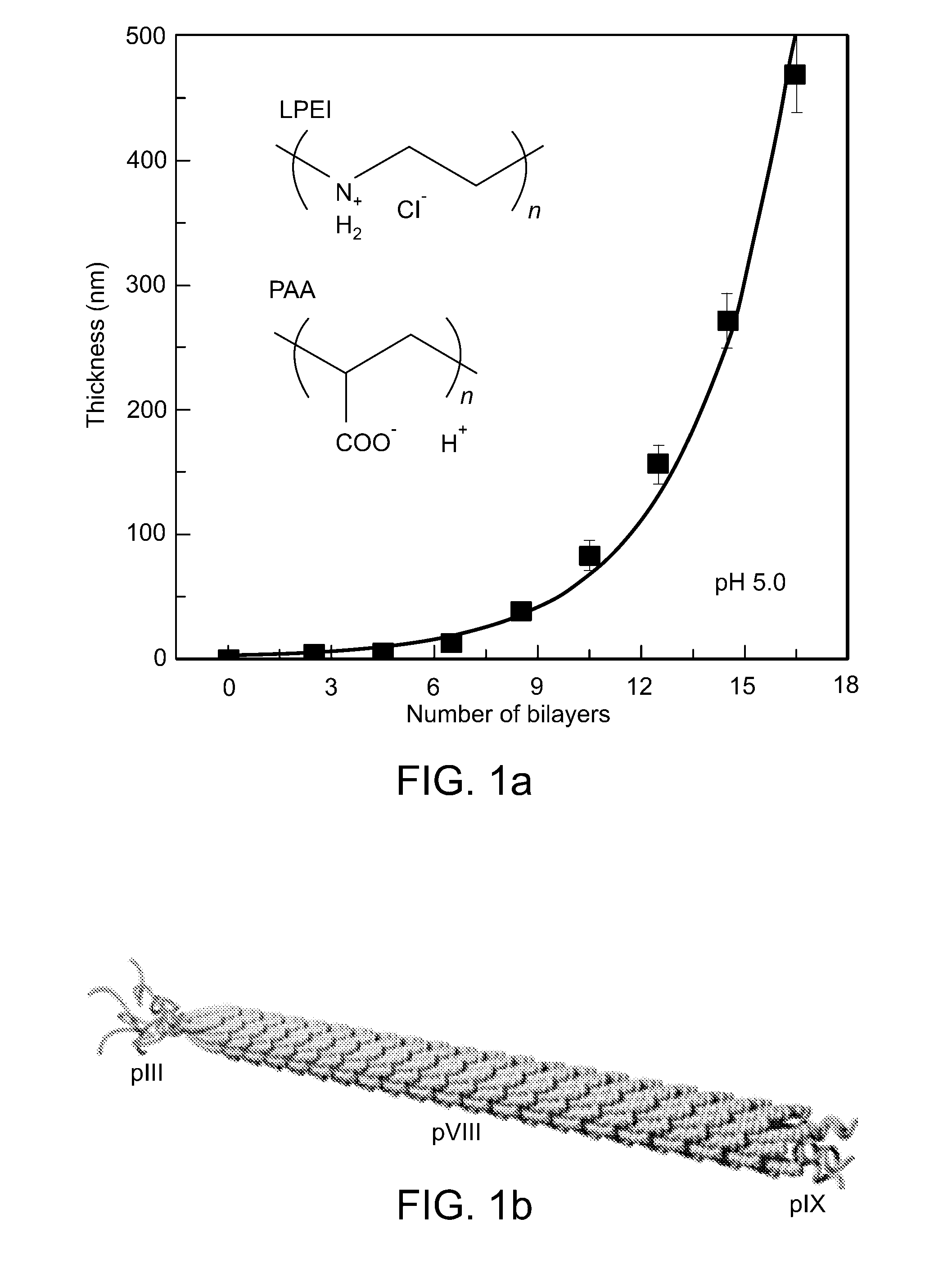Self-assembly of macromolecules on multilayered polymer surfaces
a polymer surface and macromolecule technology, applied in the field of self-assembly of macromolecules on multi-layered polymer surfaces, can solve the problems of limited material applicability, hindering the full use of this powerful technique, and the multi-layer is still poorly understood, so as to maintain film stability and function, and low cost of synthesis
- Summary
- Abstract
- Description
- Claims
- Application Information
AI Technical Summary
Benefits of technology
Problems solved by technology
Method used
Image
Examples
example 1
Spontaneous Assembly of M13 Viruses on Multilayered Polymer Surfaces
Introduction
[0129]Electrostatic interactions of repulsion and attraction that are ubiquitous in nature can be used to induce molecular mobility for ordering of nanoscopic to macroscopic systems, exemplified by separations as demonstrated in electrophoresis, or organization as in biomolecular self-assembly. In the present study, electrostatically induced interdiffusion between weakly charged polyelectrolytes drives the separation and two-dimensional (2D) liquid-crystal ordering of virus particles (M13 viruses) during alternating electrostatic assembly with complementary polyelectrolytes. In addition, because the genome of the M13 virus is easy to manipulate, the virus can be coded to grow and assemble specific inorganic materials, thus forming an ordered array of self-assembling nanowires.
[0130]The electrostatic layer-by-layer (LBL) assembly technique allows the adsorption of multiply charged species to create nanome...
example 2
Two-Dimensional Assembly of Viruses on Polyelectrolyte Multilayers for Thin, Flexible Lithium Ion Batteries
[0144]There is an increasing need for smaller and flexible Li ion batteries and for methods to assemble battery materials. Nanoparticles, nanotubes (A. S. Claye et al., J. Electrochem. Soc., 2000, 147: 2845; J. S. Sakamoto and B. Dunn, J. Electrochem. Soc., 2002, 149: A26) and nanowires (A. R. Armstrong et al., Adv. Mater., 2005, 17: 862), as well as several assembly methods, using lithography, block copolymer (S. C. Mui et al., J. Electrochem. Soc., 2002, 149: A1610), or layer-by-layer deposition (T. Cassagneau and J. H. Fendler, Adv. Mater., 1998, 10: 877), have been introduced for constructing dimensionally small batteries. In addition to their utility in nanoelectronics, there is also growing evidence that nanostructured materials can improve the electrochemical properties of Li ion batteries compared to their bulk counterparts (A. S. Arico et al., Nature Mater., 2005, 4: 3...
PUM
| Property | Measurement | Unit |
|---|---|---|
| length | aaaaa | aaaaa |
| cross-sectional diameter | aaaaa | aaaaa |
| thickness | aaaaa | aaaaa |
Abstract
Description
Claims
Application Information
 Login to View More
Login to View More - R&D
- Intellectual Property
- Life Sciences
- Materials
- Tech Scout
- Unparalleled Data Quality
- Higher Quality Content
- 60% Fewer Hallucinations
Browse by: Latest US Patents, China's latest patents, Technical Efficacy Thesaurus, Application Domain, Technology Topic, Popular Technical Reports.
© 2025 PatSnap. All rights reserved.Legal|Privacy policy|Modern Slavery Act Transparency Statement|Sitemap|About US| Contact US: help@patsnap.com



